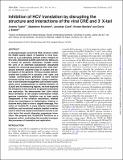Files in this item
Inhibition of HCV translation by disrupting the structure and interactions of the viral CRE and 3' X-tail
Item metadata
| dc.contributor.author | Tuplin, Andrew | |
| dc.contributor.author | Struthers, Madeleine | |
| dc.contributor.author | Cook, Jonathan | |
| dc.contributor.author | Bentley, Kirsten | |
| dc.contributor.author | Evans, David J. | |
| dc.date.accessioned | 2015-09-11T15:40:01Z | |
| dc.date.available | 2015-09-11T15:40:01Z | |
| dc.date.issued | 2015-03-11 | |
| dc.identifier | 211241365 | |
| dc.identifier | 496a9bf6-897a-491c-a08c-e32ac7efba0d | |
| dc.identifier | 000352487100042 | |
| dc.identifier | 25712095 | |
| dc.identifier | 84937611695 | |
| dc.identifier.citation | Tuplin , A , Struthers , M , Cook , J , Bentley , K & Evans , D J 2015 , ' Inhibition of HCV translation by disrupting the structure and interactions of the viral CRE and 3' X-tail ' , Nucleic Acids Research , vol. 43 , no. 5 , pp. 2914-2926 . https://doi.org/10.1093/nar/gkv142 | en |
| dc.identifier.issn | 0305-1048 | |
| dc.identifier.other | ORCID: /0000-0002-6619-2098/work/60427670 | |
| dc.identifier.other | ORCID: /0000-0002-1315-4258/work/104252556 | |
| dc.identifier.uri | https://hdl.handle.net/10023/7447 | |
| dc.description | Date of Acceptance: 12/02/2015 | en |
| dc.description.abstract | A phylogenetically conserved RNA structure within the NS5B coding region of hepatitis C virus functions as a cis-replicating element (CRE). Integrity of this CRE, designated SL9266 (alternatively 5BSL3.2), is critical for genome replication. SL9266 forms the core of an extended pseudoknot, designated SL9266/PK, involving long distance RNA-RNA interactions between unpaired loops of SL9266 and distal regions of the genome. Previous studies demonstrated that SL9266/PK is dynamic, with 'open' and 'closed' conformations predicted to have distinct functions during virus replication. Using a combination of site-directed mutagenesis and locked nucleic acids (LNA) complementary to defined domains of SL9266 and its interacting regions, we have explored the influence of this structure on genome translation and replication. We demonstrate that LNAs which block formation of the closed conformation inhibit genome translation. Inhibition was at least partly independent of the initiation mechanism, whether driven by homologous or heterologous internal ribosome entry sites or from a capped message. Provision of SL9266/PK in trans relieved translational inhibition, and mutational analysis implied a mechanism in which the closed conformation recruits a cellular factor that would otherwise suppresses translation. We propose that SL9266/PK functions as a temporal switch, modulating the mutually incompatible processes of translation and replication. | |
| dc.format.extent | 13 | |
| dc.format.extent | 874744 | |
| dc.language.iso | eng | |
| dc.relation.ispartof | Nucleic Acids Research | en |
| dc.subject | Hepatitis-C-virus | en |
| dc.subject | Internal ribosome entry | en |
| dc.subject | CIS-acting replication | en |
| dc.subject | Dependent RNA-polymerase | en |
| dc.subject | 5 nontranslated region | en |
| dc.subject | QH301 Biology | en |
| dc.subject | SDG 3 - Good Health and Well-being | en |
| dc.subject.lcc | QH301 | en |
| dc.title | Inhibition of HCV translation by disrupting the structure and interactions of the viral CRE and 3' X-tail | en |
| dc.type | Journal article | en |
| dc.contributor.institution | University of St Andrews. School of Biology | en |
| dc.contributor.institution | University of St Andrews. Biomedical Sciences Research Complex | en |
| dc.identifier.doi | 10.1093/nar/gkv142 | |
| dc.description.status | Peer reviewed | en |
This item appears in the following Collection(s)
Items in the St Andrews Research Repository are protected by copyright, with all rights reserved, unless otherwise indicated.

